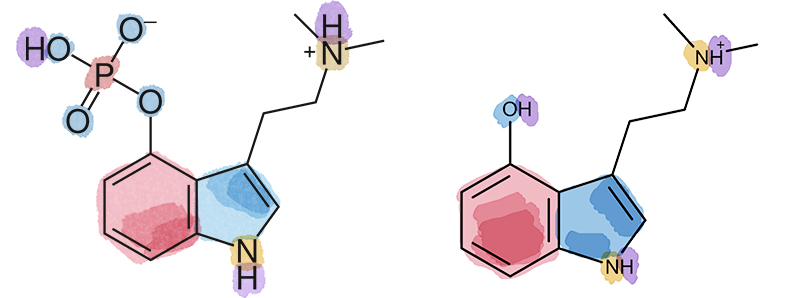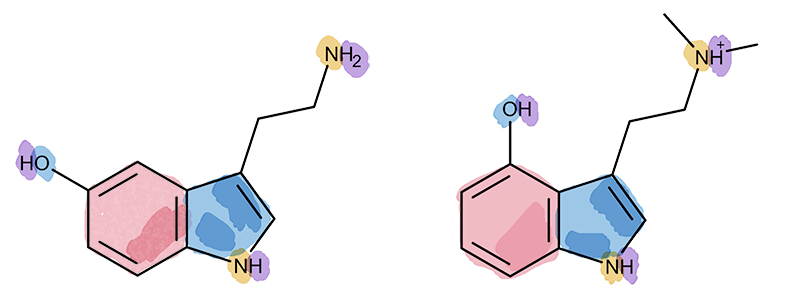In this essay, we look at the way psilocybin (and we will see, psilocin) moves through a human body and produces the psychedelic effects/experience. We will discover what exactly happens in the body, if we know what variations there are between people, and what determines the length of the psychedelic experience.
Unlike other analyses of this topic (see a great one on Psychedelic Review), we will break down each step and action. Each term we use will be defined and explained. That way we hope that anyone without previous knowledge of biology, psychology, or any other specific prerequisites will understand the metabolism of psilocybin in the body.
We don’t know everything about the metabolism of psilocybin as exactly as we may want to know. So, where needed there are disclaimers that state our uncertainty and lack of current knowledge.
Magic Mushrooms and all that is psilocybin
Magic mushrooms and truffles contain psilocybin. Psilocybin mushrooms have become quite popular, in fact. However, that isn’t the only thing they contain, and some other molecules are also psychoactive (e.g. norpsilocin/baeocystin). What can be said is that most research currently ongoing is being done with only psilocybin. In many experiments, the participants are given 25mg of pure psilocybin and that is considered a high dose (10mg is considered a low dose).
What will become one point to discuss here, and in later research, is that the dosing is based on how much someone weighs. So the dosage above is for someone weighing 70kg. For someone who weighs 100kg, the dose would be 35.7mg. One would be very interested to see how differences in body weight (and other factors like fat percentage and metabolism rate) would affect the intensity of effects.
Although other substances in mushrooms are also active (see a great list of psychoactive mushrooms here), people report the synthetic version to be of similar quality. María Sabina, a healer in Mexico who used psychedelics in her practice, said that the pills containing them had the same effect.
If taken as a mushroom button, a pill, dissolved into a tea, or ingested in another way, much of the processing of psilocybin happens further down in the body. Let’s move to the liver.
How is psilocybin metabolised in the liver?
When psilocybin finds its way to your stomach, and later on also your intestine, your blood absorbs the psilocybin. When people eat magic mushrooms, the advice is always to chew them really well so that the psilocybin can be more easily absorbed. The blood is then filtered in the liver (coming there via the hepatic portal vein) where a large part of the magic happens.
But, before we move on, there is one thing we didn’t mention about magic mushrooms/truffles, and that is that they contain a large amount of psilocin. This is the active ingredient and the one in which psilocybin will transform in our section below. So when taken in their natural form, an amount of psilocin that is about equal to psilocybin is already in the right format. So, what do we mean when we say psilocybin vs psilocin? Here it is!

Psilocybin is transformed (dephosphorylated) to psilocin through the action of enzymes called alkaline phosphates.
Let’s break this down (pun intended).
Dephosphorylation is the removal of a phosphate group from an organic compound (psilocybin in this case) by hydrolysis. Phosphate can be seen as a small group of molecules that are in this case being removed from the rest. Hydrolysis is the chemical reaction by which a water molecule ruptures the chemical bond (thus separating the phosphate group). When your body is breaking down more complex carbohydrates into glucose and fructose (sugar as we normally understand it), it’s also employing hydrolysis.
The enzymes doing this are called alkaline phosphates. Enzymes are proteins and biological catalysts that make happen or accelerate chemical reactions. Alkaline phosphates are proteins that work best in alkaline (basic not acidic, e.g. bleach) pH levels.
So in short, your body employs common mechanisms to transform psilocybin into psilocin. This process happens in the liver.
One last thing of note for the liver is the phenomenon that is called 'first pass effect'. This stands for the loss of a certain percentage of a drug (about 50% for psilocybin) that is lost during the process of absorption and that doesn't reach the blood. This process also happens with alcohol, and a reverse (strengthening effect happens with cannabis). It's unclear if everyone has the same first pass effect or if this may vary between people based on several factors (bodily, stress, activity, etc). This paper suggests that only 20% of psilocybin finds it way to become psilocin.
How does psilocin affect the brain?
Psilocin finds its way to the brain in about 30 minutes. There it interacts with the brain by mostly influencing the serotoninergic system. In a way, it mimics the function of serotonin. Serotonin itself is a monoamine neurotransmitter. It has many complex (not perfectly understood) function in the brain linked with learning, memory, happiness, and more.

The most receptors for serotonin are in the cerebral cortex (the outer part of the brain, about 40% of the brain’s mass). Psilocin binds to these and specifically 3 receptors called 5-HT2B, 5-HT2C, and 5-HT1A. The HT stands for hydroxytryptamine, which is another word for serotonin (i.e. it binds to the receptors that serotonin normally binds to). At this moment we’ve identified 7 main receptors of serotonin.
Notably, other drugs also bind to receptors for serotonin. LSD for instance also has a strong affinity for 5-HT2A. But let’s park the discussion of how different drugs work on the brain for another time.
Psilocybin has effects that are larger than only at the specific receptors for serotonin. When brains were looked at with a functional MRI (fMRI) scanner, two main things stand out. The first is that there was less blood flow (interpreted as fewer connections) between the medial prefrontal cortex (mPFC) and the posterior cingulate cortex (PCC). These effect was seen also in different ‘hub’ regions of the brain (like the thalamus and anterior cingulate cortex.
The hypothesis here is that the subjective effects of psilocybin are caused by decreased activity and connectivity in those hub regions. Thus enabling a state of unconstrained cognition.
The second finding is that psychedelics produce an ‘entropic’ brain state. Entropic here refers to being in more disorder, or being more ‘disintegrated’. This means that whilst there are fewer ‘hub’ regions being activated, the brain is overall more connected.
The changes in the brain are not only visible during the psychedelic experience (we will discuss the duration in a moment), but can also be seen on fMRI scans and subjective reports of mental health at 5 weeks. Those with the biggest changes in the brain were also those who had the best subjective outcomes.
To read more about how psilocin works in the brain (changes), the papers on the entropic/anarchic brain hypothesis are highly recommended.
How long does psilocybin last?
If our understanding is correct, after the interactions described above, psilocin is then further broken down (metabolized) by monoamine oxidase (another enzyme) into O-Glucoronide and 4-Hydroxy-indoline-3-acetaldehyde, and the latter again into 4-Hydroxy-indole-3-acetic acid and 3-Hydroxytryptophole.
The whole process, the psychedelic experience, lasts anywhere from 4 to 8 hours (with psilocybin). This is highly dependent on a variety of factors. The first is the dosage, the more someone takes, the longer (and heavier) the effects may be. The amount of psilocybin (and psilocin) per mushroom (variety and/or batch) may of course also differ widely.
Based on a study with 18 volunteers the duration of the psychedelic experience was generally over at the 7-hour mark. The most measurable bodily effects (e.g. blood pressure) were seen after two hours. The biggest drug effects (e.g. joy/intense happiness and overall drug effect) were seen after three hours.
Alas, at this time we can't find studies that have looked further into the other factors mentioned earlier (stress, metabolism, etc). What was done in this study, and many subsequent studies, is that the dose was dependant on the bodyweight of the participant. This does make sense if psilocybin is evenly distributed throughout the body.
Conclusion
So, how long does psilocybin stay in your body? We hope that this article has made it a little more clear how psilocybin (and then psilocin) is metabolized in the body. From your stomach, it finds a way to your liver and then your brain. There it mimics serotonin to make the psychedelic experience happen and changes the way your brain communicates.
There is still much we can learn about the psychedelic experience. Over time researchers will find new ways of measuring, adjusting, and enhancing the psychedelic experience. May we live in interesting times.
Do also read this excellent resource on dosing.
Become a psychedelic insider
Get a Pro Membership to enjoy these benefits & support Blossom📈 full reports on Topics & Compounds
🧵 full summary reviews of research papers
🚀 full access to new articles
See Memberships

